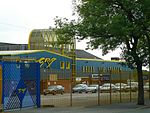Gorton Monastery
19th-century Roman Catholic church buildings in the United KingdomE. W. Pugin church buildingsEngvarB from October 2017Franciscan monasteries in EnglandGrade II* listed Roman Catholic churches in England ... and 8 more
Grade II* listed buildings in ManchesterGrade II* listed churches in ManchesterInfobox religious building with unknown affiliationRecollectsRoman Catholic churches completed in 1872Roman Catholic churches in Greater ManchesterRoman Catholic churches in ManchesterTourist attractions in Manchester

The Church and Friary of St Francis, known locally as Gorton Monastery, is a Grade II* listed former Franciscan friary in Gorton, Manchester, England. It was designed by the noted Victorian architect Edward Welby Pugin amd built 1866–1872. Gorton Monastery is a noted example of Gothic Revival architecture. The building ceased to be used for Christian worship in 1989 and fell derelict for many years. After a restoration programme, it reopened as a secular events venue in 2007.
Excerpt from the Wikipedia article Gorton Monastery (License: CC BY-SA 3.0, Authors, Images).Gorton Monastery
Gorton Lane, Manchester Openshaw
Geographical coordinates (GPS) Address Website External links Nearby Places Show on map
Geographical coordinates (GPS)
| Latitude | Longitude |
|---|---|
| N 53.468305555556 ° | E -2.1875 ° |
Address
The Monastery Manchester
Gorton Lane
M12 5WF Manchester, Openshaw
England, United Kingdom
Open on Google Maps





